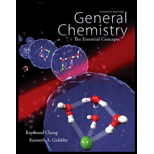
Concept explainers
Interpretation:
Calculation of standard potential and emf of
Concept introduction:
In an
Standard potential of a cell (Eocell) is the potential measured at 298K, 1 atm pressure with electrolyte concentration of 1 M. It can be calculated by the below equation.
The standard potential for the reduction half (cathode) and the oxidation half (anode) were measured in relative with standard hydrogen electrode (SHE) at standard temperature and pressure with electrolyte concentration of 1M.
In our case the standard potential of the cell can be calculated by the following reaction
Electro motive force (emf) of the reaction can be calculated by Nernst equation:
Eocell = standard potential of a cell
R = universal gas constant (8.31 J mole-1 K-1)
T = Absolute temperature in Kelvin
F = Faraday constant, number of coulombs per mole of electron (96845 C/mole)
n = Number of electrons transferred in the cell reaction
Q = Reaction quotient
Since the cell reaction takes place at room temperature (298K), so the Nernst equation was simplified as
Further the above equation can be written in terms of log10
Want to see the full answer?
Check out a sample textbook solution
Chapter 19 Solutions
Package: General Chemistry with Connect 2-year Access Card
 ChemistryChemistryISBN:9781305957404Author:Steven S. Zumdahl, Susan A. Zumdahl, Donald J. DeCostePublisher:Cengage Learning
ChemistryChemistryISBN:9781305957404Author:Steven S. Zumdahl, Susan A. Zumdahl, Donald J. DeCostePublisher:Cengage Learning ChemistryChemistryISBN:9781259911156Author:Raymond Chang Dr., Jason Overby ProfessorPublisher:McGraw-Hill Education
ChemistryChemistryISBN:9781259911156Author:Raymond Chang Dr., Jason Overby ProfessorPublisher:McGraw-Hill Education Principles of Instrumental AnalysisChemistryISBN:9781305577213Author:Douglas A. Skoog, F. James Holler, Stanley R. CrouchPublisher:Cengage Learning
Principles of Instrumental AnalysisChemistryISBN:9781305577213Author:Douglas A. Skoog, F. James Holler, Stanley R. CrouchPublisher:Cengage Learning Organic ChemistryChemistryISBN:9780078021558Author:Janice Gorzynski Smith Dr.Publisher:McGraw-Hill Education
Organic ChemistryChemistryISBN:9780078021558Author:Janice Gorzynski Smith Dr.Publisher:McGraw-Hill Education Chemistry: Principles and ReactionsChemistryISBN:9781305079373Author:William L. Masterton, Cecile N. HurleyPublisher:Cengage Learning
Chemistry: Principles and ReactionsChemistryISBN:9781305079373Author:William L. Masterton, Cecile N. HurleyPublisher:Cengage Learning Elementary Principles of Chemical Processes, Bind...ChemistryISBN:9781118431221Author:Richard M. Felder, Ronald W. Rousseau, Lisa G. BullardPublisher:WILEY
Elementary Principles of Chemical Processes, Bind...ChemistryISBN:9781118431221Author:Richard M. Felder, Ronald W. Rousseau, Lisa G. BullardPublisher:WILEY





